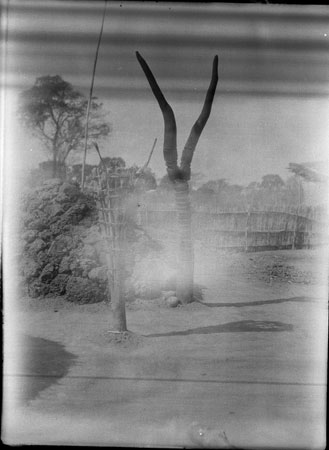Bongo rain-shrine and grave

103 x 75 mm | Negative film nitrate
Date of Print:
Unknown
Previous PRM Number:
EP.B.40
Previous Other Number:
66 5
Accession Number:
1998.343.36
Description:
A rain-making shrine of an unusual type compared to other Bongo rain-posts (riyak), and rather more like in form a Zande tuka or ancestral shrine.
It was situated under a large tree, with ground swept well around it.
The female operator of the shrine threw water over it with an invocation to spirits during drought, since she was widely considered to be possessed and closely associated with ancestral spirits.
Directly behind it is a grave mound with forked tally grave post [image cloudy at centre].
Photographer:
Edward Evan Evans-Pritchard
Date of Photo:
1929 March
Region:
[Southern Sudan] Warab Tonj-Yambio Road
Group:
Bongo
PRM Source:
Edward Evan Evans-Pritchard
Acquired:
Donated 1966
Other Owners:
E. E. Evans-Pritchard Collection
Class:
Ritual , Ritual Object , Death , Carving
Keyword:
Grave , Grave Marker , Shrine
Primary Documentation:
PRM Accession Records - Accession Book Entry [p.
98] 1966.27 [1 - 24] G[ift] PROFESSOR E.
E.
EVANS-PRITCHARD; INST.
OF SOCIAL ANTHROPOLOGY, 51 BANBURY RD.
OXFORD - 1966.27.19 - S.
SUDAN, DARFUNG.
VARIOUS TRIBES.
Box of negatives in envelopes, [1 - 242] & 1966.27.20 - Box of prints of these negatives [refers to object 1966.27.19] [1 - 242], in envelopes.
Other Information:
In "The Bongo" (Sudan Notes and Records Vol.XII Part I 1929 page 27) E.
E.
Evans-Pritchard notes that 'I saw a third shrine on the old Tonj-Yambio road.
This was not a simple post like others which I saw, but was a somewhat elaborate shrine such as the Azande build for the ancestral spirits, and which they call Tuka.
It was made of kolome wood and was situated under a mama tree.
The ground all around it was well swept.
There were some maize cobs, with the seed partly eaten by birds, tied over the shrine, and in the basket-shaped head of the shrine itself were some ground-nuts, and on top of it was an empty cup-gourd.
A woman is the officiator at this shrine, and she told me that her father and mother had not been rain-makers and that she had no rain medicines.
Her claim to erect and officiate at the shrine is based on the fact that sometimes she has what appear to be fits, for the spirits lift her up and throw her down on the ground.
In the winter she collects water from holes in stone flats and she keeps it in a pot in her house.
Then, if there is a drought in the rainy season, she will dream that she is to make rain and will summon the people round to come with foodstuffs.
She takes water from her pot in a cup-gourd and carrying it in her hand to the shrine, she throws it into the air, crying "Loma, we are dying for lack of water, rain come and fall on us lest we die!" The woman is a be loma gubu which, I believe, means one possessed with the spirits.
The shrine in this instance seems to be a mixture of Zande and Dinka cultures.
The placing of the shrine under a tree and the technique are either Luo (Shilluk) or Dinka in origin, whereas the actual shrine itself is of a type to be found in any Zande village, and is connected with ancestor-cult.' [Chris Morton 16/1/2004]
Recorder:
Christopher Morton 16/1/2004 [Southern Sudan Project]

